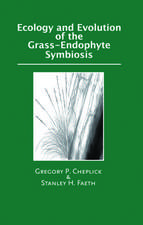Chemical Signals in Vertebrates 10
Editat de R.T. Mason, Michael P. Lemaster, Dietland Müller-Schwarzeen Limba Engleză Hardback – 8 iun 2005
| Toate formatele și edițiile | Preț | Express |
|---|---|---|
| Paperback (1) | 1223.88 lei 43-57 zile | |
| Springer Us – 29 oct 2010 | 1223.88 lei 43-57 zile | |
| Hardback (1) | 1226.73 lei 43-57 zile | |
| Springer Us – 8 iun 2005 | 1226.73 lei 43-57 zile |
Preț: 1226.73 lei
Preț vechi: 1496.01 lei
-18% Nou
Puncte Express: 1840
Preț estimativ în valută:
234.79€ • 241.97$ • 198.22£
234.79€ • 241.97$ • 198.22£
Carte tipărită la comandă
Livrare economică 03-17 martie
Preluare comenzi: 021 569.72.76
Specificații
ISBN-13: 9780387251592
ISBN-10: 0387251596
Pagini: 432
Ilustrații: XII, 430 p. 115 illus.
Dimensiuni: 155 x 235 x 25 mm
Greutate: 0.7 kg
Ediția:2005
Editura: Springer Us
Colecția Springer
Locul publicării:New York, NY, United States
ISBN-10: 0387251596
Pagini: 432
Ilustrații: XII, 430 p. 115 illus.
Dimensiuni: 155 x 235 x 25 mm
Greutate: 0.7 kg
Ediția:2005
Editura: Springer Us
Colecția Springer
Locul publicării:New York, NY, United States
Public țintă
ResearchCuprins
Perspectives in Chemical Ecology.- Thirty years on the odor trail: From the first to the tenth international symposium on chemical signals in vertebrates.- Pheromones: Convergence and contrasts in insects and vertebrates.- Intraspecific Behavior.- The discovery and characterisation of splendipherin, the first anuran sex pheromone.- Chemically mediated mate recognition in the tailed frog (ascaphus truei).- Responses to sex- and species-specific chemical signals in allopatric and sympatric salamander species.- The pheromonal repelling response in red-spotted newts (Notophthalmus viridescens).- The effects of cloacal secretions on brown tree snake behavior.- Species and sub-species recognition in the North American beaver.- Self-grooming in meadow voles.- Protein content of male diet does not influence proceptive or receptive behavior in female meadow voles, Microtus pennsylvanicus.- The signalling of competitive ability by male house mice.- A possible function for female enurination in the mara, Dolichotis patagonum.- The evolution of perfume-blending and wing sacs in emballonurid bats.- Behavioral responsiveness of captive giant pandas (Ailuropoda melanoleuca) to substrate odors from conspecifics of the opposite sex.- Chemical signals in giant panda urine (Ailuropoda melanoleuca).- Chemical communication of musth in captive male asian elephants, Elephas maximus.- Chemical analysis of preovulatory female african elephant urine: A search for putative pheromones.- Assessing chemical communication in elephants.- The gland and the sac — the preorbital apparatus of muntjacs.- The chemistry of scent marking in two lemurs: Lemur catta and Propithecus verreauxi coquereli.- Soiled bedding from group-housed females exerts strong influence on male reproductive condition.- The roleof the major histocompatibility complex in scent communication.- Characterisation of proteins in scent marks: Proteomics meets semiochemistry.- The “scents” of ownership.- The role of scent in inter-male aggression in house mice & laboratory mice.- Chemical signals and vomeronasal system function in axolotls (Ambystoma mexicanum).- From the eye to the nose: Ancient orbital to vomeronasal communication in tetrapods?.- Prey chemical signal transduction in the vomeronasal system of garter snakes.- Mode of delivery of prey-derived chemoattractants to the olfactory and vomeronasal epithelia results in differential firing of mitral cells in the main and accessory olfactory bulbs of garter snakes.- Communication by mosaic signals: Individual recognition and underlying neural mechanisms.- Sexual dimorphism in the accessory olfactory bulb and vomeronasal organ of the gray short-tailed opossum, Monodelphis domestica.- The neurobiology of odor-based sexual preference the case of the golden hamster.- Retention of olfactory memories by newborn infants.- Human sweaty smell does not affect women’s menstrual cycle.- Interspecific Responses.- Local predation risk assessment based on low concentration chemical alarm cues in prey fishes: Evidence for threat-sensitivity.- Learned recognition of heterospecific alarm cues by prey fishes: A case study of minnows and stickleback.- The response of prey fishes to chemical alarm cues: What recent field experiments reveal about the old testing paradigm.- Response of juvenile goldfish (Carassius auratus) to chemical alarm cues: Relationship between response intensity, response duration, and the level of predation risk.- The effects of predation on phenotypic and life history variation in an aquatic vertebrate.- Nocturnal shift in theantipredator response to predator-diet cues in laboratory and field trials.- Long-term persistence of a salamander anti-predator cue.- Decline in avoidance of predator chemical cues: Habituation or biorhythm shift?.- Chemically mediated life-history shifts in embryonic amphibians.- Latent alarm signals: Are they present in vertebrates?.- Blood is not a cue for poststrike trailing in rattlesnakes.- Rattlesnakes can use airborne cues during post-strike prey relocation.- The sense of smell in procellariiforms: An overview and new directions.- Cottontails and gopherweed: Anti-feeding compounds from a spurge.
Caracteristici
Robert T. Mason is a well-known and respected name in the study of vertebrates, specifically in chemical signaling between vertebrates. He serves as the J.C. Braly Curator of Vertebrates in the Zoology Department at Oregon State University, where he also runs the Mason Lab Includes supplementary material: sn.pub/extras















